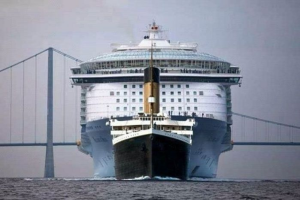Titanic vs Modern Cruise Ship
When it comes to maritime history, few stories capture the imagination quite like that of the Titanic. The tragic sinking of the Titanic in 1912 marked a turning point in the way we perceive travel and ship safety. Over a century later, the evolution of technology has given rise to a new era of cruise ships that boast incredible advancements in design, safety, and amenities. This article takes you on a journey through time and technology, comparing the Titanic to modern cruise ships.
The Titanic Era: Glamour and Tragedy
The Grandeur of the Titanic
In the early 20th century, the Titanic was a marvel of engineering and luxury. Its sheer size and opulent interiors were unparalleled, with grand ballrooms, luxurious cabins, and elegant dining rooms. The ship’s first-class accommodations redefined luxury travel.
The Tragic End
Despite its grandeur, the Titanic’s maiden voyage ended in disaster. Striking an iceberg on its journey, the ship’s lack of sufficient lifeboats resulted in the loss of over 1,500 lives. This disaster prompted significant changes in maritime regulations and safety protocols.
Modern Cruise Ships: Engineering Wonders
Technological Advancements
Modern cruise ships are a testament to human innovation. Advanced navigation systems, radar technology, and satellite communication ensure safer voyages. Moreover, stability systems and propulsion mechanisms contribute to a smoother and more efficient cruising experience. Also read about the travel destinations in the world Best Countries to Visit in October
Design and Comfort
Contemporary cruise ships prioritize both safety and passenger comfort. Innovative hull designs and stabilization technology minimize the impact of rough seas, allowing for a more enjoyable journey. State-of-the-art cabins, entertainment options, and recreational facilities provide passengers with an unforgettable experience.
Sustainability and Environmental Consciousness
Unlike the Titanic era, modern cruise ships emphasize environmental sustainability. Advanced waste management systems, energy-efficient technologies, and cleaner fuel sources demonstrate the industry’s commitment to reducing its ecological footprint.
A Glimpse into the Future
The Rise of Smart Ships
The future of cruise travel is set to be dominated by smart technology. Predictive analytics, AI-driven guest experiences, and virtual reality entertainment are just a few examples of how technology will transform the cruising experience. Also, read more about How Many Instruments Did Prince Play: A Musical Journey
Alternative Energy Sources
As the world shifts towards renewable energy, cruise ships are exploring alternative power sources such as liquefied natural gas (LNG) and even hydrogen fuel cells. These innovations not only reduce emissions but also pave the way for a more sustainable future.
Space Tourism and Beyond
Beyond traditional cruise ships, the concept of space tourism is rapidly becoming a reality. While a far cry from the Titanic, this new frontier in travel showcases the remarkable extent of human ingenuity and exploration.

Entertainment and Activities
While the Titanic’s entertainment primarily consisted of live music and card games, today’s cruise ships offer an extensive array of entertainment options, from Broadway-style shows to rock-climbing walls and virtual reality experiences.
Environmental Considerations
In the wake of environmental concerns, modern cruise ships incorporate green technologies like wastewater treatment systems and exhaust gas cleaning. The Titanic, on the other hand, lacked such considerations, reflecting the contrasting priorities of its era.
Cuisine and Dining Options
Dining on the Titanic was a lavish affair, but modern cruise ships take culinary experiences to new heights, offering a diverse range of gourmet cuisines and dining styles that cater to various palates.
Crew and Staff
The Titanic’s crew worked diligently under challenging conditions. Today’s cruise ships prioritize crew welfare, reflecting a more empathetic approach that acknowledges the vital role crew members play in enhancing passenger experiences.
Global Impact and Cultural Resonance
The Titanic’s sinking left a lasting impact on maritime regulations and travel culture. In comparison, modern cruise ships have contributed to global tourism and cultural exchange, with a focus on enriching the lives of passengers through global exploration.
Comparing Luxury and Accessibility
While the Titanic’s luxury was reserved for the privileged few, modern cruise ships have made luxury more accessible, allowing a wider range of travellers to experience opulence at sea.
Economic Factors: Cost and Affordability
The economics of maritime travel have evolved. Adjusted for inflation, a Titanic ticket was a luxury for the elite. Today, increased accessibility and competition have made cruising a more affordable vacation option.
Advancements in Navigation and Communication
The Titanic’s tragic fate was exacerbated by limited communication and navigation tools. Modern cruise ships benefit from satellite communication, real-time weather forecasting, and advanced navigation systems that ensure safer voyages.

Conclusion
The Titanic and modern cruise ships stand as a testament to the incredible advancements made in maritime technology over the years. From the tragedy of the Titanic’s sinking to the marvels of modern engineering, the cruise industry has evolved to prioritize safety, comfort, and sustainability. As we look to the future, the possibilities are limitless, with smart technology and alternative energy sources shaping the way we experience travel.
FAQs
Were there any survivors of the Titanic disaster?
Yes, there were survivors from the Titanic disaster. Approximately 705 out of the around 2,224 passengers and crew members on board survived the tragic sinking.
How has navigation technology improved since the Titanic era?
Navigation technology has seen remarkable improvements since the Titanic era. Modern cruise ships use satellite-based navigation systems, radar, and GPS technology for more accurate and safe voyages.
What safety measures are in place on modern cruise ships?
Modern cruise ships have stringent safety measures, including advanced lifeboat systems, improved stability technology, mandatory safety drills, and strict adherence to international maritime regulations.
What are some examples of alternative energy sources used on cruise ships?
Cruise ships are exploring alternative energy sources like liquefied natural gas (LNG) and solar power. These sources help reduce emissions and the environmental impact of cruising.
Are there any plans for underwater exploration of the Titanic wreck?
Yes, various underwater explorations of the Titanic wreck have taken place over the years. Advanced remotely operated vehicles (ROVs) are used to capture images and study the wreckage in detail.
